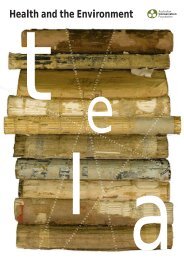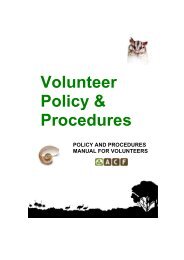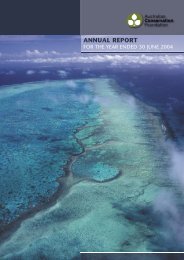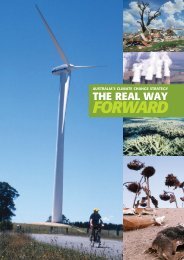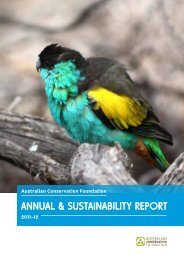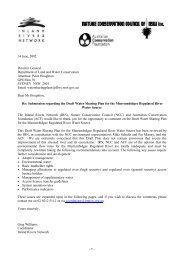Protecting Western Australia's Big Blue Backyard - The Pew ...
Protecting Western Australia's Big Blue Backyard - The Pew ...
Protecting Western Australia's Big Blue Backyard - The Pew ...
- No tags were found...
Create successful ePaper yourself
Turn your PDF publications into a flip-book with our unique Google optimized e-Paper software.
MAINTAINING AUSTRALIA'S INTERNATIONALREPUTATION IN MARINE PROTECTIONWhen the Australian Government signed theUnited Nations Convention on the Law of the Sea,which came into force in 1994, Australia was giventhe right to use the Exclusive Economic Zone(out to 200 nautical miles) for social and economicbenefits. With that right came the formalresponsibility for the huge area of the world’smarine environment entrusted to our care.This responsibility, Australia’s commitmentsunder the international Convention on BiologicalDiversity and our participation in IUCN’s programpromoting the establishment of a globalrepresentative system of marine protected areas,saw Australian governments agree on a planof action in 1998 for the National RepresentativeSystem of Marine Protected Areas (NRSMPA).Since that time the NRSMPA has been indevelopment across Australia. All types ofmarine protected areas within it now covermore than nine per cent of Australia’s marineenvironment. Just over four per cent is coveredby no-take protection.Looking after a marine environment as largeas <strong>Western</strong> Australia’s big blue backyard isan enormous responsibility, but Australia iswell-placed to do so. We have a stablegovernment system, a history of internationalleadership in marine protection, the necessaryscientific expertise and a community that isseeking action.By establishing a CAR network of large no-takemarine reserves, the Australian Government wouldput in place the critical foundation necessaryto secure the health of the region’s unique andimportant species and ecosystems, and <strong>Western</strong>Australia’s social and economic future.In time, the next step will be to ensure thatall industries using Australian waters are trulysustainable, operating within the constraintsof the marine ecosystems that support them.<strong>The</strong> starting point is to lay the cornerstone ofmarine protection: large no-take marine reserves.Creating effective and credible marine protectedareas is a big challenge. <strong>The</strong> marine environmentis immense, complex and interconnected.Marine reserves cannot be effective unless theyare of a size and protection level that matchesthe ecosystems and the geographical ranges ofspecies they seek to protect.This was recognised by the US Governmentwhich established two of the world’s three largestno-take marine protected areas in US waters.In 2006 the US Government created thePapahãnaumokuãkea Marine National Monumentin the north-western Hawaiian Islands covering365,000 square kilometres. This was followed withmarine national monument protection given to500,000 square kilometres in the Mariana Trench,the northern Mariana Islands, the Rose Atoll anda chain of Central Pacific islands in early 2009.Prior to the declaration of these large, ecologicallyvaluable and diverse marine protected areas, thelargest marine reserve was in the marine watersof the tiny Pacific nation of Kiribati, with no-takeprotection covering 410,000 square kilometres.Australia is seen as a leader in protection of themarine environment, largely due to protection ofthe Great Barrier Reef, as well as Heard, McDonaldand Macquarie islands in our sub-Antarctic waters.<strong>The</strong> 2003 rezoning of the Great Barrier Reef MarinePark, with its expansion of the no-take green zonesto cover one third of the marine park, receivedinternational acclaim.However, this reputation should not be takenfor granted. A recent analysis by WWF-Australiarevealed that the marine environment in theSouth-east Marine Region was not adequatelyprotected by the Commonwealth network ofmarine reserves established there in late 2007.Creating a CAR network of large no-take marinereserves in <strong>Western</strong> Australia’s big blue backyardis vital to maintaining our international reputationin marine protection.<strong>Western</strong> Australia has always been largerthan life, politically, economically, socially andenvironmentally. Its marine environment is nodifferent. <strong>Big</strong> values need big protection.THE MANY BENEFITS OFMARINE PROTECTIONWe can protect the big values of <strong>Western</strong>Australia’s big blue backyard by establishing aCAR network of large no-take marine reservesbetween Kalbarri and Eucla. <strong>The</strong>se will protectthe habitats and feeding, breeding, nursery andresting areas of the region’s marine life.Allowing marine life to survive and thrive in theKalbarri to Eucla region will help commercialand recreational fishers keep putting fish on thetable, so we will still see ‘gone fishing’ signs inwindows. Jobs in <strong>Western</strong> Australia will continueto grow in the marine-based industries of thefuture, including whale watching and the dive andecotourism sectors, at the same time as many ofthe great natural values elsewhere in the world’soceans disappear.By reducing or eliminating threats, marineprotection can give marine life greater resistanceto climate change. More abundant marine life andundisturbed sea floor sediments can also help fightthat change by storing carbon.<strong>The</strong> creation of a CAR network of large no-takemarine reserves is the most effective way to protectthe threatened whales, sharks, tuna and other fish,seals and seabirds of the region. Ranging acrosslarge areas, each relies on very specific places atdifferent times in their life cycle in order to feed,take shelter, find mates, breed and grow.<strong>The</strong> movement of water, nutrients and marine lifecreates strong connections between estuaries,inshore and offshore waters and from the sea floorto the surface. Many animals living on the bottomrely on the nutrients that rain down from thesurface, while fish that grow up in estuaries oftenspend their adult lives in open waters. Largeno-take marine reserves can help protect theseand many other ecological connections andnatural life cycles across the region.Large no-take marine reserves will also protectthe vital role of the biggest connector of all inthe region, the Leeuwin Current. In large reservesthe marine life will increase in abundance and theLeeuwin Current will carry that benefit along theregion. But if we allow the region’s marine life todecline, then the Current will have fewer larvae,fish, coral polyps and other marine life to transport,causing the region to suffer.<strong>The</strong> creation of a CAR network of large no-takemarine reserves will also send a message that weas a nation highly value our marine life. This willencourage improved marine management andbetter catchment management, reducing thethreats to those marine reserves that have linksto inshore waters and estuaries.Weedy seadragons are endemic tosouthern Australia’s cooler waterswhere they are threatened byharvesting for the aquarium trade andaccidental catch in fishing nets© Gary Bell / OceanwideImages.comLarge no-take marine reserves are not ‘no-go’areas. Non-extractive uses such as diving, scientificresearch, ecotourism and education will continue,benefiting from improved marine health. Shippingand sailing will continue as before.<strong>The</strong> Australian Government can now bestow thesebenefits to <strong>Western</strong> Australia’s big blue backyardby establishing a CAR network of large no-takemarine reserves that will again see our nation atthe forefront of international efforts to protectthe world’s oceans.10



